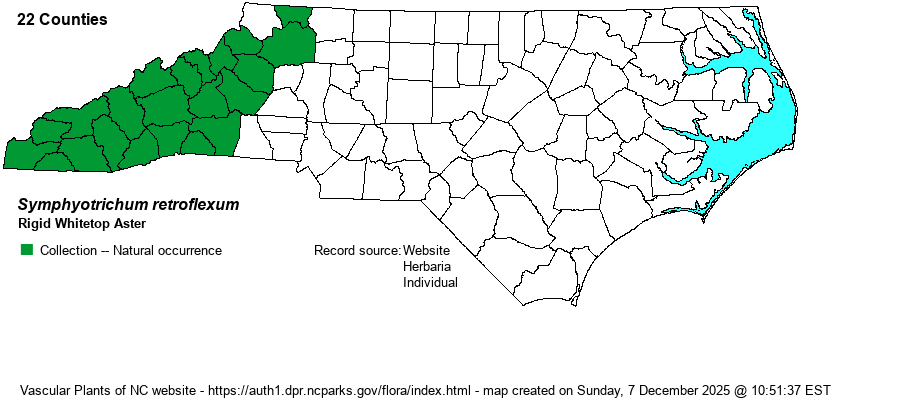| Author | (Lindley ex de Candolle) Nesom | |
| Distribution | Mountains and upper Piedmont, at middle to high elevations.
Blue Ridge of NC, TN, SC, and GA (Weakley 2018). FNA also includes VA and AL, but definitely not known in VA (not in the Digital Atlas of the Virginia Flora website). | |
| Abundance | Generally common in the middle and higher elevations, rarely in lower elevations; scarce near the VA border, as it is absent in that state. Known from all montane counties except for Ashe. | |
| Habitat | Moist soil of montane woodlands and forests, openings in these forests, shady roadbanks; sometimes in open meadows. | |
| Phenology | Flowering and fruiting late August-October. | |
| Identification | Rigid Whitetop Aster has lance-shaped to narrowly elliptic or even linear leaves, blue to violet ray florets, and green, recurved involucral bracts. It may be thought of as a montane representative of New York Aster (S. novi-belgii), which in NC occurs only in the Coastal Plain. Some plants may look similar to S. prenanthoides, but that plant has leaf bases that clasp the stem (vs. not). Rigid Whitetop Aster, better known to NC residents as Curtis's Aster, is a common montane aster of wooded borders and roadbanks, less so in deep forests; and it is also one of the more attractive asters in that region, best told by the smooth and narrowly elliptic to linear stem leaves (that are barely serrated) and the spreading bracts. | |
| Taxonomic Comments | NOTE: The genus Aster was examined by G.L. Nesom (1994), who determined that it was composed of a number of discrete genera (a few of which were already split off by authors as Sericocarpus, Ionactis, etc.). The earliest available name for North American "Aster" is Symphyotrichum, a name regrettably long and hard to spell.
A synonym is Aster curtisii.
| |
| Other Common Name(s) | Curtis's Aster, the former most often used name when the species was named as Aster curtisii. Rigid Whitetop Aster, used by nearly all references now, is a puzzling name. What is the "whitetop" part of the name referring to? The flowers are lavender-blue, and the bracts are green! | |
| State Rank | S4 | |
| Global Rank | G3G5 | |
| State Status | | |
| US Status | | |
| USACE-agcp | | |
| USACE-emp | | |

